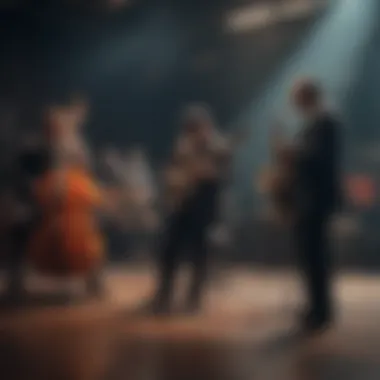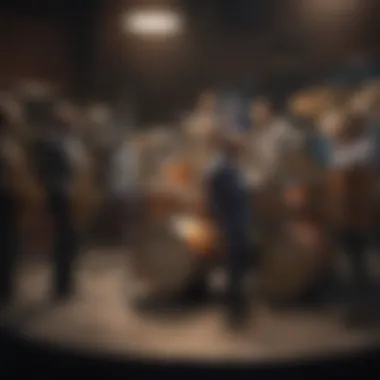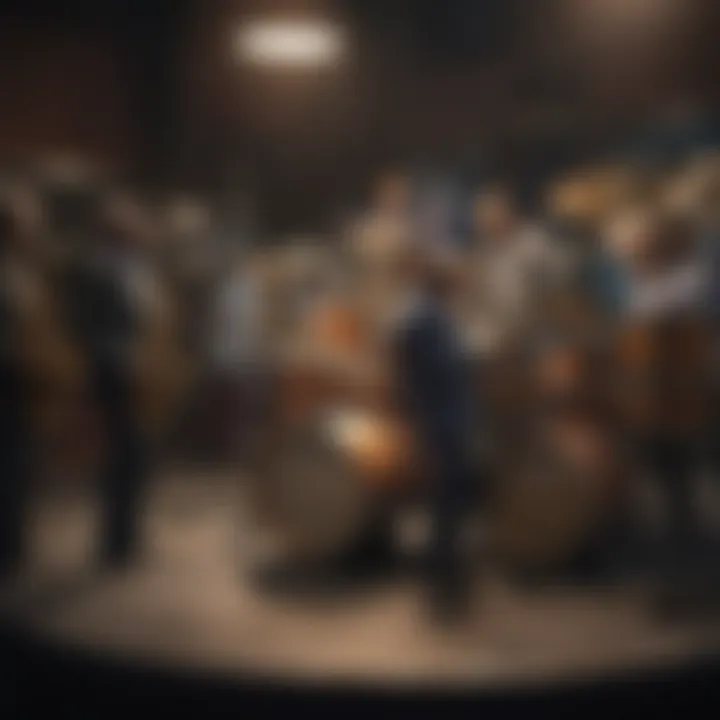Exploring Jazz Fusion: Origins and Influences Unveiled


Intro
Jazz fusion is a vibrant and complex genre that emerged in the late 1960s. It represents a unique blend of jazz with various musical styles, including rock, funk, R&B, and world music. The term "jazz fusion" can be seen as a reflection of the broader changes happening in music and culture during this time. Musicians began to experiment with sound, harmony, and rhythm, pushing the boundaries of traditional jazz. This article aims to explore the origins, evolution, and influence of jazz fusion, providing a deeper understanding of its place in the music landscape.
Artist Profile
Biography and Background
Jazz fusion is marked by the contributions of numerous artists who have played a crucial role in shaping the genre. Notably, Miles Davis stands out as one of the most significant figures in jazz. Born on May 26, 1926, in Alton, Illinois, he began his career in bebop but successfully transitioned into fusion with his groundbreaking album "Bitches Brew" in 1970. Davis’s exploration of electric instruments and innovative compositional techniques paved the way for a new era in jazz.
Major Influences and Inspirations
Miles Davis was influenced by a variety of styles and musicians. His exposure to rock music, particularly the work of artists like Jimi Hendrix and Sly and the Family Stone, inspired him to incorporate electric instruments into his music. Other notable influences include John Coltrane and Ornette Coleman, who contributed to the development of modal jazz and free jazz, respectively. The merging of these diverse influences is a hallmark of the jazz fusion genre.
Song Analysis
Theme and Lyrics Breakdown
Songs within the jazz fusion genre often reflect a rich tapestry of themes. Unlike traditional jazz, which may focus more on instrumental prowess, fusion often includes lyrics that address social issues, personal experiences, and abstract concepts. For instance, in Davis’s famous track "Miles Runs the Voodoo Down," the lyrics convey a sense of urgency and exploration of the spiritual.
Instrumentation and Composition
The instrumentation in jazz fusion distinguishes it from other genres. Electric guitars, synthesizers, and various percussion instruments combine to create a layered sound. Musicians experiment with rhythm and freedom in their compositions. Artists like Chick Corea and Weather Report have used complex structures and polyrhythms, enhancing the depth of their music.
"Jazz fusion transcends traditional boundaries, creating a unique dialogue among various musical genres."
Epilogue
In summary, jazz fusion embodies a transformative period in music history. It not only reflects the personal journeys of its key figures but also signifies a broader cultural movement. By examining its origins and evolution, one can appreciate the rich influences that have shaped jazz fusion into a significant force within the music ecosystem.
Through understanding these dimensions, music enthusiasts and aspiring musicians can gain insight into their own creative expressions and the role of tradition in contemporary music.
Understanding Jazz Fusion
Understanding jazz fusion is vital for grasping its significance in the music landscape. This section aims to provide a comprehensive foundation for recognizing the genre's unique characteristics and historical context. Jazz fusion emerged as a response to the evolving musical climate, integrating diverse influences to create a fresh sound that captured the imaginations of musicians and audiences alike.
Jazz fusion is characterized by its blend of various musical styles, often combining traditional jazz elements with rock, funk, and world music influences. This melding creates a dynamic sound that challenges standard musical conventions. As we unpack this topic, we will explore how jazz fusion not only reflects individual expression but also serves as a cultural commentary through its innovative approach to music.
Definition and Characteristics
Jazz fusion represents a groundbreaking convergence of jazz improvisation with the rhythmic and harmonic elements of rock and funk. This genre is not simply a mixture; it is an evolution that redefined jazz as a form.
Key characteristics include:
- Complex Time Signatures: Unlike traditional jazz, fusion often employs irregular time signatures, enhancing its rhythmic complexity.
- Extended Harmonic Structures: Musicians in this realm utilize intricate chord progressions that challenge and expand upon foundational jazz harmonies.
- Electric Instruments: The use of electric guitars, synthesizers, and bass guitars played a significant role in shaping the sound of jazz fusion, moving away from acoustic timbres.
- Improvisational Freedom: Even within structured pieces, artists retain extensive freedom for improvisation, staying true to the jazz roots.
These elements distinguish jazz fusion, appealing to a niche audience while also attracting listeners from other genres. Understanding these defining features gives insight into why jazz fusion is both revered and critiqued by purists and innovators alike.
The Musicians Behind the Genre
The evolution of jazz fusion cannot be separated from the influential musicians who crafted its sound. These artists not only pushed the boundaries of what jazz could be but also integrated their diverse backgrounds into their work. Among the notable figures are:
- Miles Davis: A pioneer in jazz, Davis's album "Bitches Brew" is often credited with popularizing the jazz fusion movement.
- Chick Corea: As a keyboardist and composer, Corea's contributions through groups like Return to Forever showcased the genre's potential.
- Herbie Hancock: Known for his innovative approach, Hancock fused electronic music with jazz elements, notably in "Headhunters."
- John McLaughlin: The guitarist's work with the Mahavishnu Orchestra exemplified the complex arrangements and high-energy performances characteristic of fusion.
Understanding these musicians and their unique contributions is critical for anyone looking to deepen their comprehension of jazz fusion. Their collective innovations have shaped the genre, influencing countless artists and paving the way for its growth across multiple musical landscapes.
"Jazz fusion marked an important intersection of musical styles, where creativity flourished beyond traditional boundaries."
Through this exploration of definition and key musicians, the foundation for jazz fusion's broader context is established, paving the way for discussions about its historical development and influences.


Historical Context of Jazz Fusion
In understanding jazz fusion, a critical aspect lies within its historical context. This genre, emerging primarily in the late twentieth century, highlights an intersection between traditional jazz and various other musical elements. These connections are not merely arbitrary; they reveal the socio-cultural dynamics that motivated musicians to explore new sonic territories. Analyzing the origins and evolutione of jazz fusion provides insight into its significance in the music world today.
Originating in the Late Twentieth Century
Jazz fusion surfaced around the late 1960s, a period marked by experimentation and change within the music scene. Musicians sought to break free from the constraints of traditional jazz forms. The rise of electric instruments allowed for a different sound, appealing to a younger, more diverse audience. Artists like Miles Davis began to explore this new direction with albums such as "Bitches Brew," which served as a catalyst for the genre. The socio-political climate also played a crucial role, as the civil rights movement and counterculture influenced artists to reflect these themes in their work.
The Influence of Traditional Jazz
Traditional jazz provided the foundational rhythms, harmonies, and structures upon which fusion developed. While jazz fusion incorporates elements from rock, funk, and Latin music, it does not reject its roots. Instead, it builds upon them. Improvisation remains central in fusion, similar to its predecessor. However, the fusion genre distinguished itself by introducing more complex compositions, often merging disparate musical styles into a coherent whole. This blending not only broadened the audience but also created a new vocabulary in musical expression.
Integration of Other Genres
Jazz fusion is characterized by its eclectic nature, seamlessly integrating various genres. The influence of rock brought about a more energizing and vigorous approach. Similarly, African rhythms and Latin elements enriched its texture. This genre also embraced electronic music, leading to innovative uses of synthesizers and other tech. The fusion of these many styles resulted in a rich tapestry of sound, making it possible for artists to express complex emotional landscapes.
"Jazz fusion is not merely a combination of genres; it’s a conversation that reflects societal changes, technological advancements, and personal artistic exploration."
The impact of these inter-genre dialogues is significant. Jazz fusion has not only shaped the careers of numerous musicians, encouraging them to experiment and innovate, but it has also affected the larger music industry. By understanding its historical context, we appreciate jazz fusion not only as a genre but also as a movement that continues to inspire creativity and collaboration today.
Key Developments in Jazz Fusion
Jazz fusion is a dynamic genre that brings together various musical elements. The development of jazz fusion has been influenced by multiple factors, primarily focusing on innovative instrumentations, rhythms, and technology. Understanding these key developments is essential for recognizing how jazz fusion evolved and how artists continue to push creative boundaries.
The Rise of Electric Instruments
Electric instruments marked a turning point in jazz fusion. The transition from acoustic to electric instruments allowed musicians greater flexibility and expression. Instruments like the electric guitar and bass provided new textures and sound possibilities. Artists could manipulate their sound using effects pedals, creating unique sonic landscapes.
The use of electric pianos also transformed jazz music. Instruments such as the Fender Rhodes became staples in fusion bands. This led to a new style that blended traditional jazz phrasing with contemporary techniques. Electric instruments broadened the appeal of jazz fusion beyond traditional jazz audiences, attracting listeners from rock and pop backgrounds.
Innovations in Rhythm and Harmony
Rhythmic innovation is another cornerstone of jazz fusion's development. Musicians began experimenting with complex time signatures and polyrhythms. This was a departure from the straightforward rhythms commonly found in earlier jazz styles. The blending of various musical genres allowed for new rhythmic patterns that added depth and complexity.
On the harmonic side, jazz fusion embraced modal scales and extended chord progressions. This opened new avenues for improvisation. Chord changes became less predictable, challenging musicians to think creatively. These innovations provided a fresh canvas for artistic expression and redefined traditional jazz paradigms.
The Role of Technology
Technology plays a significant role in the evolution of jazz fusion. Advancements in recording techniques and live sound engineering allowed musicians to capture performances in new ways. Multi-track recording became prevalent, enabling artists to layer sounds and create intricate compositions.
Moreover, synthesizers played a crucial role in shaping the sound of jazz fusion. Instruments like the Minimoog introduced electronic sounds into acoustic settings. This fusion of technology and musicianship expanded the genre's artistic horizons. The accessibility of music production software has also enabled aspiring musicians to create fusion-style music without needing extensive studio setup.
"The rise of electric instruments and technology redefined not just jazz fusion but also the way musicians interact with their craft."
In summary, the key developments in jazz fusion highlight the genre’s adaptability and innovation. As electric instruments found their place, rhythmic and harmonic explorations flourished. Alongside technology, these elements combined to create a vibrant and evolving musical landscape.
Influential Artists and Their Contributions
The role of influential artists in jazz fusion cannot be overstated. These musicians have reshaped the genre, pushing boundaries and introducing innovative concepts. They contribute to the ongoing evolution of jazz fusion, making it a dynamic field. Each artist brings a unique style that intertwines various musical traditions, adding depth and texture to the genre. Understanding their contributions is essential for anyone wishing to grasp the full scope of jazz fusion.
Miles Davis and the Birth of Bitches Brew
Miles Davis is often seen as a pivotal figure in jazz fusion, especially with his 1970 album, Bitches Brew. This work marked a significant departure from his earlier styles, incorporating electric instruments and rock elements. Davis's fusion of jazz with rock, funk, and electronic sounds set a precedent for many future musicians. The album showcases improvisation driven by a collective spirit. Also, it emphasizes collective interplay among the musicians, blurring the lines between structured composition and spontaneous creation.
"Bitches Brew" represents a new era, combining jazz with unexpected elements. Its influence is pervasive in various music genres.
Weather Report's Impact on the Genre
Weather Report further expanded jazz fusion's horizons. Founded by Joe Zawinul and Wayne Shorter, the group is celebrated for its innovative compositions and dynamic soundscapes. Their 1977 album Heavy Weather featured the hit "Birdland," which remains a staple in jazz fusion. Weather Report played with rhythm and harmony, integrating complex time signatures and layering instrumental harmonies. The band’s use of synthesizers also contributed to the evolving sound of jazz fusion, inspiring countless musicians to experiment.


Chick Corea and the Elektric Band
Chick Corea was another significant contributor to jazz fusion, particularly through his work with the Elektric Band. This group melded elements of jazz, funk, and Latin music, creating a fresh sound that resonated with audiences. Corea's use of synthesizers and electric piano brought a new dimension to the genre. Albums like Electric Band spotlight his innovative compositions and virtuosic piano skills. Corea's knack for blending various musical influences has made him a cornerstone in the jazz fusion narrative.
Herbie Hancock's Trailblazing Path
Herbie Hancock stands out for his role in jazz fusion, combining traditional jazz with electronic and funk music. His album Head Hunters is one of the best-selling jazz albums of all time, introducing jazz-funk to the mainstream. Hancock’s work often features intricate melodies and engaging rhythms, showcasing his creativity. His willingness to embrace technology and collaboration with diverse musicians has influenced many in the contemporary jazz scene. His legacy inspires emerging artists exploring fusion's boundaries today.
Signature Albums in Jazz Fusion
Signature albums play a critical role in the development and popularization of jazz fusion. They encapsulate the creativity and experimentation that define the genre, serving as benchmarks for future artists. These albums showcase the unique blend of styles that jazz fusion represents by integrating elements from traditional jazz, rock, funk, and various world music traditions. Dissecting these pivotal works provides insight into the genre’s evolution and its lasting impact on contemporary music.
Analyzing Bitches Brew
Miles Davis’s Bitches Brew is often regarded as the catalyst for jazz fusion. Released in 1970, this album marked a departure from conventional jazz forms. It features an eclectic mix of musicians and instruments, resulting in an innovative sound that combined electric instruments with traditional jazz elements. The album’s approach to improvisation and studio production was groundbreaking.
Davis utilized layers of sound and extensive manipulation in the recording process, creating an otherworldly atmosphere. The use of electric pianos, synthesizers, and a full array of percussion instruments contributed to its rich textural landscape. Notably, tracks like "Pharaoh's Dance" and "Spanish Key" illustrate the shift towards a more expansive and genre-blending definition of jazz.
Bitches Brew not only reshaped Davis’s career but also established a new framework for countless musicians who followed. Its influence is evident across various music genres, encouraging artists to experiment and explore.
Heavy Weather by Weather Report
Released in 1977, Heavy Weather is another cornerstone in the realm of jazz fusion. Renowned for its track "Birdland," the album showcases Weather Report’s unique blend of melodies and complex rhythms. Joe Zawinul and Wayne Shorter led the ensemble, pushing the sonic boundaries of what jazz could encompass.
The album combines intricate arrangements with accessible melodies, making it a landmark effort that drew a wider audience. Heavy Weather's fusion of acoustic and electric instruments, along with its incorporation of elements from Latin and funk music, demonstrates a high level of musical sophistication. In fact, this album served as a template for creating commercially successful and artistically ambitious works in the jazz fusion landscape.
Return to Forever: An Overview
Return to Forever, led by Chick Corea, is another seminal project within jazz fusion. The band’s self-titled album first released in 1972, exemplifies the complex and vibrant nature of fusion. Corea’s innovative compositions, influenced by a variety of sources including classical music and Latin rhythms, showcased the versatility of jazz fusion.
The album includes tracks that meld intricate melodic lines with powerful rhythmic sections. Use of electric keyboards and synthesizers stands out, illustrating the drive towards modernity in jazz. The musicianship displayed on Return to Forever continues to inspire young musicians, highlighting the importance of collaboration in creating multifaceted music.
"The beauty of jazz fusion lies in its continuous evolution, representing a dialogue between diverse musical traditions."
Global Influences and Cross-Pollinations
The phenomenon of jazz fusion cannot be understood without recognizing its connections to various global musical traditions. This section will explore how diverse musical influences contribute richness and complexity to the genre. By examining specific elements, we gain insight into how jazz fusion transcends geographical boundaries. This synthesis not only broadens the sonic palette but also underscores the genre's adaptability and evolution.
Latin Elements in Jazz Fusion
Latin music has played a significant role in shaping jazz fusion. The percussion instruments commonly found in Latin music, such as congas and timbales, introduce new textures and rhythms. Artists like Tito Puente have merged these elements with traditional jazz, creating a vibrant soundscape. The incorporation of rhythms such as salsa and bossa nova provides a rhythmic complexity, allowing jazz fusion to explore intricate polyrhythms.
- Key Contributions:
- Use of Latin percussion to enhance rhythmic depth.
- Fusion of melodic elements from bolero and samba.
- Artists such as Chick Corea and his band Return to Forever showcase this blend.
The Influence of African Rhythms
African musical traditions contribute foundational grooves and syncopation to jazz fusion. The emphasis on rhythm, often reflected in African drumming, has a profound impact on jazz musicians. It invites innovative approaches to time and improvisation, pushing artists to rethink their rhythmic structures.
"Rhythm is the heart of music; without it, we are lost."
- Characteristics Noted:
- Call-and-response patterns that invigorate performances.
- Complex polyrhythms reflecting West African musical styles.
- Artists like Art Blakey incorporate African aspects into their jazz works.
Asian Music's Role in Fusion
Asian music, particularly from countries like India and Japan, provides additional layers of influence in jazz fusion. Indian classical music introduces concepts such as raga and tala, which can modify melodic and rhythmic phrasing in jazz. Similarly, the use of scales, found in Asian modalities, expands the harmonic language of jazz fusion.


- Influential Aspects:
- Incorporation of sitar by artists like Ravi Shankar in fusion settings.
- Modal improvisation inspired by Eastern scales.
- The global appeal of Asian musical forms invites collaboration among diverse artists.
In summary, the global influences and cross-pollinations that characterize jazz fusion create a dynamic and evolving musical form. By immersing in these cultural exchanges, musicians can create innovative expressions, enriching the landscape of jazz fusion further.
Transformative Trends in Contemporary Jazz Fusion
The landscape of jazz fusion continues to evolve, incorporating new influences and responding to changes in musical culture. This section examines significant trends that are reshaping the genre today. These trends reflect the growing diversity and innovation that define contemporary jazz fusion, highlighting how artists are adapting to the times while maintaining the core elements of the form.
Emergence of Neo-Fusion
Neo-fusion stands as a prominent trend in today’s jazz fusion scene, representing a revival and reimagining of earlier styles combined with substantial contemporary ideas. This movement seeks to blend traditional jazz fusion elements with modern genre influences, such as hip-hop, electronic music, and even pop. Musicians are increasingly experimenting with new technology and soundscapes to create rich, layered compositions that resonate with audiences.
One notable aspect of neo-fusion is its accessibility. Emerging artists often leverage digital platforms for distribution and promotion. This democratization allows for a broader range of voices to be heard. Artists harness social media to share their work, engage with fans, and collaborate across geographical boundaries. The result is a diverse array of sounds and styles, offering fresh interpretations of jazz fusion.
The Role of Independent Artists
The role of independent artists in contemporary jazz fusion cannot be overstated. With the advent of digital technology and streaming services, artists can produce and share their work without the need for major record labels. This independence fosters creativity and risk-taking, leading to innovative projects that might have otherwise gone unheard.
Independent artists often blur genre lines further than mainstream acts, collaborating with musicians from various backgrounds. These collaborations can introduce unconventional elements into traditional jazz fusion, enriching its fabric and expanding its audience. The result is an ever-evolving genre that reflects the complexities of modern music.
"Jazz fusion is not merely a genre; it is a dialogue between diverse forms of expression, continually redefining itself through the contributions of innovative artists across the globe."
In summary, the trends of neo-fusion and the rise of independent artists are pivotal in shaping the contemporary jazz fusion landscape. They signal a departure from strict genre definitions, welcoming innovation and encouraging a collaborative spirit. As these trends unfold, they enhance the richness and relevance of jazz fusion in today’s musical world.
The Cultural Significance of Jazz Fusion
Jazz fusion emerged as more than just a musical genre; it represents a cultural movement that interweaves numerous musical traditions, innovations, and social narratives. By examining its cultural significance, we can appreciate how fusion not only reshaped the landscape of music but also influenced broader social and political contexts. This section focuses on how jazz fusion acts as a bridge between diverse musical styles and communities, reflecting the complexities of modern culture.
Jazz Fusion as a Cultural Movement
Jazz fusion began as an exploration of boundaries, combining elements from jazz, rock, funk, and various international styles. It became a form of expression that mirrored the sociocultural changes of the late twentieth century. As urbanization took hold, artists found inspiration in the eclectic sounds of the city, leading to a genre that is as much about experimentation as it is about tradition.
Key characteristics of jazz fusion as a cultural movement include:
- Collaboration among musicians: Bands often consisted of players from different backgrounds, encouraging a melting pot of ideas and styles.
- Cultural exchange: Traditional jazz musicians working with rock and funk artists allowed for a unique mix that brought together diverse audiences.
- Globalization of music: Fusion emphasized the importance of cross-cultural influences, making music not just a local affair but a global dialogue.
This genre emerged in a period marked by social upheaval, racial tensions, and a quest for new identities. As musicians blended genres, they also blended cultures. For instance, musicians like Chick Corea and Herbie Hancock often incorporated Latin rhythms and African beats into their compositions.
Impact on Social and Political Themes
Jazz fusion has a notable impact on social and political themes, often serving as a critique or reflection of prevailing issues. The genre provides a canvas for addressing topics such as identity, race, and inequality. In many jazz fusion compositions, the improvisational element signifies freedom of expression, a core tenet during a time of political and social change.
In particular, fusion artists used their platform to challenge social norms. The music spoke to issues such as:
- Racial equality: By collaborating across genres, musicians broke down barriers that were prevalent in mainstream music.
- Cultural identity: Jazz fusion allowed artists to assert their identities and heritage, contributing to a broader narrative that values diversity.
- Resistance and protest: Some works became emblematic of resistance movements, using the power of music to mobilize audiences.
In summary, jazz fusion has transcended its role as merely a genre. It serves as a representation of cultural and social evolution, enabling conversations that resonate beyond the music itself. As we look at the future of jazz fusion, its ongoing influence remains significant, encapsulating a rich history of artistic freedom and societal reflection.
Looking Forward: The Future of Jazz Fusion
The future of jazz fusion stands as a reflection of its dynamic history. As this genre adapts, it not only preserves its past but also counters the prevailing musical trends of the moment. The ongoing evolution of jazz fusion considers various intersection points between genre innovations and societal changes. Understanding this future is essential, especially as it provides insights into how musicians navigate creativity and technology, shaping a sound that remains relevant. The blend of styles, genres, and influences ensures that jazz fusion continually evolves while retaining its core principles.
Evolving Musical Landscapes
As we look ahead, musical landscapes are shifting, inviting a new generation of artists to explore uncharted territories. Today’s musicians are influenced by an array of global sounds, from hip-hop to world music. In this context, jazz fusion is experiencing a reinvention. Emerging artists experiment by varying rhythms, adding their cultural influences, and redefining improvisation. The fruitful collaborations are noteworthy; artists often blend genres to create unique soundscapes.
The fusion of electronic elements with traditional jazz further pushes the boundaries of the genre. New ensembles incorporate diverse instruments, engaging in cross-genre experimentation that reflects the current social climate. They create fresh dialogues by using the structural improvisation characteristic of jazz to enhance various musical forms.
Technological Advancements Shaping the Genre
Technology plays a crucial role in the future of jazz fusion. Advancements in musical equipment and software allow artists to experiment and produce sounds that were previously unimaginable. Digital audio workstations facilitate collaborative efforts among musicians from different locations, stimulating new ideas and influences. This connectivity fosters a culture of creativity that is vital for the genre’s expansion.
Moreover, social media and streaming platforms have democratized music consumption. Artists can now reach broader audiences without traditional industry barriers. Platforms such as Spotify, SoundCloud, and online video channels enable jazz fusion musicians to showcase their work directly to fans. Consequently, this visibility transforms how musicians engage with their audiences, allowing for immediate feedback and interaction.







